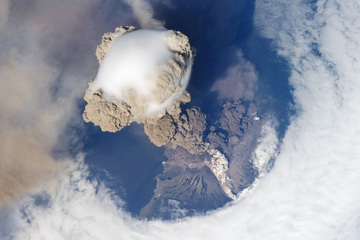4.4: Earth’s Surface Features
- Page ID
- 12785
\( \newcommand{\vecs}[1]{\overset { \scriptstyle \rightharpoonup} {\mathbf{#1}} } \)
\( \newcommand{\vecd}[1]{\overset{-\!-\!\rightharpoonup}{\vphantom{a}\smash {#1}}} \)
\( \newcommand{\id}{\mathrm{id}}\) \( \newcommand{\Span}{\mathrm{span}}\)
( \newcommand{\kernel}{\mathrm{null}\,}\) \( \newcommand{\range}{\mathrm{range}\,}\)
\( \newcommand{\RealPart}{\mathrm{Re}}\) \( \newcommand{\ImaginaryPart}{\mathrm{Im}}\)
\( \newcommand{\Argument}{\mathrm{Arg}}\) \( \newcommand{\norm}[1]{\| #1 \|}\)
\( \newcommand{\inner}[2]{\langle #1, #2 \rangle}\)
\( \newcommand{\Span}{\mathrm{span}}\)
\( \newcommand{\id}{\mathrm{id}}\)
\( \newcommand{\Span}{\mathrm{span}}\)
\( \newcommand{\kernel}{\mathrm{null}\,}\)
\( \newcommand{\range}{\mathrm{range}\,}\)
\( \newcommand{\RealPart}{\mathrm{Re}}\)
\( \newcommand{\ImaginaryPart}{\mathrm{Im}}\)
\( \newcommand{\Argument}{\mathrm{Arg}}\)
\( \newcommand{\norm}[1]{\| #1 \|}\)
\( \newcommand{\inner}[2]{\langle #1, #2 \rangle}\)
\( \newcommand{\Span}{\mathrm{span}}\) \( \newcommand{\AA}{\unicode[.8,0]{x212B}}\)
\( \newcommand{\vectorA}[1]{\vec{#1}} % arrow\)
\( \newcommand{\vectorAt}[1]{\vec{\text{#1}}} % arrow\)
\( \newcommand{\vectorB}[1]{\overset { \scriptstyle \rightharpoonup} {\mathbf{#1}} } \)
\( \newcommand{\vectorC}[1]{\textbf{#1}} \)
\( \newcommand{\vectorD}[1]{\overrightarrow{#1}} \)
\( \newcommand{\vectorDt}[1]{\overrightarrow{\text{#1}}} \)
\( \newcommand{\vectE}[1]{\overset{-\!-\!\rightharpoonup}{\vphantom{a}\smash{\mathbf {#1}}}} \)
\( \newcommand{\vecs}[1]{\overset { \scriptstyle \rightharpoonup} {\mathbf{#1}} } \)
\( \newcommand{\vecd}[1]{\overset{-\!-\!\rightharpoonup}{\vphantom{a}\smash {#1}}} \)
\(\newcommand{\avec}{\mathbf a}\) \(\newcommand{\bvec}{\mathbf b}\) \(\newcommand{\cvec}{\mathbf c}\) \(\newcommand{\dvec}{\mathbf d}\) \(\newcommand{\dtil}{\widetilde{\mathbf d}}\) \(\newcommand{\evec}{\mathbf e}\) \(\newcommand{\fvec}{\mathbf f}\) \(\newcommand{\nvec}{\mathbf n}\) \(\newcommand{\pvec}{\mathbf p}\) \(\newcommand{\qvec}{\mathbf q}\) \(\newcommand{\svec}{\mathbf s}\) \(\newcommand{\tvec}{\mathbf t}\) \(\newcommand{\uvec}{\mathbf u}\) \(\newcommand{\vvec}{\mathbf v}\) \(\newcommand{\wvec}{\mathbf w}\) \(\newcommand{\xvec}{\mathbf x}\) \(\newcommand{\yvec}{\mathbf y}\) \(\newcommand{\zvec}{\mathbf z}\) \(\newcommand{\rvec}{\mathbf r}\) \(\newcommand{\mvec}{\mathbf m}\) \(\newcommand{\zerovec}{\mathbf 0}\) \(\newcommand{\onevec}{\mathbf 1}\) \(\newcommand{\real}{\mathbb R}\) \(\newcommand{\twovec}[2]{\left[\begin{array}{r}#1 \\ #2 \end{array}\right]}\) \(\newcommand{\ctwovec}[2]{\left[\begin{array}{c}#1 \\ #2 \end{array}\right]}\) \(\newcommand{\threevec}[3]{\left[\begin{array}{r}#1 \\ #2 \\ #3 \end{array}\right]}\) \(\newcommand{\cthreevec}[3]{\left[\begin{array}{c}#1 \\ #2 \\ #3 \end{array}\right]}\) \(\newcommand{\fourvec}[4]{\left[\begin{array}{r}#1 \\ #2 \\ #3 \\ #4 \end{array}\right]}\) \(\newcommand{\cfourvec}[4]{\left[\begin{array}{c}#1 \\ #2 \\ #3 \\ #4 \end{array}\right]}\) \(\newcommand{\fivevec}[5]{\left[\begin{array}{r}#1 \\ #2 \\ #3 \\ #4 \\ #5 \\ \end{array}\right]}\) \(\newcommand{\cfivevec}[5]{\left[\begin{array}{c}#1 \\ #2 \\ #3 \\ #4 \\ #5 \\ \end{array}\right]}\) \(\newcommand{\mattwo}[4]{\left[\begin{array}{rr}#1 \amp #2 \\ #3 \amp #4 \\ \end{array}\right]}\) \(\newcommand{\laspan}[1]{\text{Span}\{#1\}}\) \(\newcommand{\bcal}{\cal B}\) \(\newcommand{\ccal}{\cal C}\) \(\newcommand{\scal}{\cal S}\) \(\newcommand{\wcal}{\cal W}\) \(\newcommand{\ecal}{\cal E}\) \(\newcommand{\coords}[2]{\left\{#1\right\}_{#2}}\) \(\newcommand{\gray}[1]{\color{gray}{#1}}\) \(\newcommand{\lgray}[1]{\color{lightgray}{#1}}\) \(\newcommand{\rank}{\operatorname{rank}}\) \(\newcommand{\row}{\text{Row}}\) \(\newcommand{\col}{\text{Col}}\) \(\renewcommand{\row}{\text{Row}}\) \(\newcommand{\nul}{\text{Nul}}\) \(\newcommand{\var}{\text{Var}}\) \(\newcommand{\corr}{\text{corr}}\) \(\newcommand{\len}[1]{\left|#1\right|}\) \(\newcommand{\bbar}{\overline{\bvec}}\) \(\newcommand{\bhat}{\widehat{\bvec}}\) \(\newcommand{\bperp}{\bvec^\perp}\) \(\newcommand{\xhat}{\widehat{\xvec}}\) \(\newcommand{\vhat}{\widehat{\vvec}}\) \(\newcommand{\uhat}{\widehat{\uvec}}\) \(\newcommand{\what}{\widehat{\wvec}}\) \(\newcommand{\Sighat}{\widehat{\Sigma}}\) \(\newcommand{\lt}{<}\) \(\newcommand{\gt}{>}\) \(\newcommand{\amp}{&}\) \(\definecolor{fillinmathshade}{gray}{0.9}\) Earth’s surface features are the result of constructive and destructive forces. Constructive forces cause landforms to grow. The eruption of a new volcano creates a new landform. Destructive forces wear landforms down. The slow processes of mechanical and chemical weathering and erosion work over time to change once high mountains into smooth flat plateaus.
Earth’s surface features are the result of constructive and destructive forces. Constructive forces cause landforms to grow. The eruption of a new volcano creates a new landform. Destructive forces wear landforms down. The slow processes of mechanical and chemical weathering and erosion work over time to change once high mountains into smooth flat plateaus.
- The continents are large land areas extending from high mountaintops to sea level.
- The ocean basins extend from the edges of the continents down steep slopes to the ocean floor and into deep trenches.
Continents
The oldest continental rocks are billions of years old, so the continents have had a lot of time for things to happen to them. Constructive forces cause physical features on Earth’s surface known as landforms to grow. Crustal deformation—when crust compresses, pulls apart, or slides past other crust—results in hills, valleys, and other landforms. Mountains rise when continents collide, when one slab of ocean crust plunges beneath another or a slab of continental crust to create a chain of volcanoes. Sediments are deposited to form landforms, such as deltas.
Volcanic eruptions can also be destructive forces that blow landforms apart. The destructive forces of weathering and erosion modify landforms. Water, wind, ice, and gravity are important forces of erosion. This scene is within the East African Rift where the crust is being pulled apart to form a large valley.
- Which features result from constructive forces? Volcanoes have been constructed within the valley by rising magma.
- Which features result from destructive forces? Volcanic explosions or collapses have destroyed volcanic mountains to form craters. Fractures caused by the rifting in the valley are signs that the valley is breaking apart. Streams are eroding downward into the slopes of the volcanoes. Landslides erode the steep volcanoes. A landslide scar is seen on left side of the small, very steep volcanic cone near the center of the image, and landslide deposits have traveled outward from the scar.

Ocean Basins
The ocean basins are all younger than 180 million years. Although the ocean basins begin where the ocean meets the land, the continent extends downward to the seafloor, so the continental margin is made of continental crust.The ocean floor itself is not totally flat. The most distinctive feature is the mountain range that runs through much of the ocean basin, known as the mid-ocean ridge. The deepest places of the ocean are the ocean trenches, many of which are located around the edge of the Pacific Ocean. Chains of volcanoes are also found in the center of the oceans, such as in the area of Hawaii. Flat plains are found on the ocean floor with their features covered by mud.
Changing Earth
Earth’s surface changes over short and long periods of time. Constructive forces cause new features to form by volcanic activity or uplift of the crust. Existing landforms are modified by destructive forces, perhaps even eroded away by water, wind, ice, and gravity. Beneath the oceans, volcanic activity forms new seafloor while old seafloor is destroyed at the trenches.
- Dynamic Earth: Introduction to Physical Geography. Authored by: R. Adam Dastrup. Located at: http://www.opengeography.org/physical-geography.html. Project: Open Geography Education. License: CC BY-SA: Attribution-ShareAlike
- Sarychev Peak Eruption, Kuril Islands. Provided by: NASA. Located at: http://earthobservatory.nasa.gov/NaturalHazards/view.php?id=38985. Project: Earth Observatory . License: Public Domain: No Known Copyright
- Oceanic basin. Authored by: Chris_huh. Located at: https://commons.wikimedia.org/wiki/File:Oceanic_basin.svg. License: Public Domain: No Known Copyright

